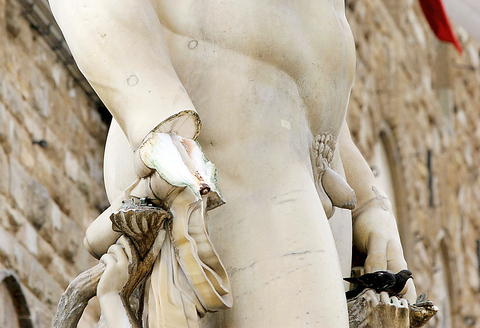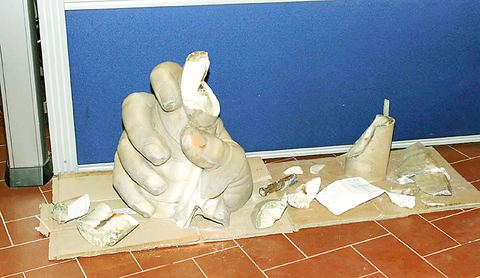She whole operation took 54 seconds.
The famous Neptune fountain in Florence, which took baroque architect Bartolomeo Ammanati 12 painstaking years from 1563 to 1575 to create, had a hand of the sea god broken off.
The vandal, a 28-year-old cook from Tuscany, was identified from surveillance camera images. The man told his lawyers he was "in a state of euphoria" when he climbed the statue on Aug. 3 to take a photo with his mobile phone.

PHOTO: EPA
Year after year, when temperatures in the Italian capital soar, art vandals, acting either out of boredom or drunkenness, take aim at historical monuments.
The most dramatic incident dates back to 1972 when a 33-year-old Hungarian rushed into St Peter's Basilica and exclaimed, "I am Jesus Christ!" before destroying Michelangelo's Pieta with a hammer.
The face of Christ's mother was badly damaged and one of her arms was severed. An Italian court later pronounced the perpetrator, Laszlo Toth, insane. Toth later emigrated to Australia.

Ever since experts have been asking what motivates people to inflict damage on treasured works of art.
"Was Toth so traumatized by the beauty of the statue that he acted out of despair?" wondered one art historian in an essay years later.
The answer is probably much more mundane, if the example of the three middle-aged men who, in 1997, used Bernini's Four Rivers fountain in Rome as a diving board is anything to go by.
In trying to impress onlooking tourists in Rome's Piazzo Navona, the men climbed up the marble structure, breaking the tail of an ornamental sea creature into little pieces, "as it were made of plaster," a journalist with La Repubblica daily recalled.
"I don't know what all the fuss is about. We only wanted to have a bit of fun" the men told police afterwards. The ringleader was later sentenced to three months in prison, which he appealed on the grounds that the fountain was in a state of disrepair.
In 1991, it was Michelangelo's most famous sculpture that took a beating: A serial offender took a hammer to David, which is on display in Florence's Galleria dell'Accademia, knocking off its toes. Eight years later the same man scribbled on a painting by American abstract artist Jackson Pollock in Rome.
And the list of art-related vandalism attacks continues, from Bernini's Bee fountain on Rome's Via Veneto to the entrance door of Milan Cathedral, to the works by French painter Henri Matisse which a schoolgoer perforated with a pen at an exhibition in Rome in 1998.
The consequence of these acts is that more and more Italian works of art are disappearing behind protective panes of glass, including the restored Pieta in St Peter's Basilica. Neptune's return to Florence's Piazza della Signoria is slated for early 2006.
"We must reconsider our laws (on this type of crime), because we heading towards complete anarchy," said Florence-based art expert Antonio Paolucci. "The sanctions are currently so weak you'd think we were talking about defacing a street sign."

On April 26, The Lancet published a letter from two doctors at Taichung-based China Medical University Hospital (CMUH) warning that “Taiwan’s Health Care System is on the Brink of Collapse.” The authors said that “Years of policy inaction and mismanagement of resources have led to the National Health Insurance system operating under unsustainable conditions.” The pushback was immediate. Errors in the paper were quickly identified and publicized, to discredit the authors (the hospital apologized). CNA reported that CMUH said the letter described Taiwan in 2021 as having 62 nurses per 10,000 people, when the correct number was 78 nurses per 10,000

As we live longer, our risk of cognitive impairment is increasing. How can we delay the onset of symptoms? Do we have to give up every indulgence or can small changes make a difference? We asked neurologists for tips on how to keep our brains healthy for life. TAKE CARE OF YOUR HEALTH “All of the sensible things that apply to bodily health apply to brain health,” says Suzanne O’Sullivan, a consultant in neurology at the National Hospital for Neurology and Neurosurgery in London, and the author of The Age of Diagnosis. “When you’re 20, you can get away with absolute

May 5 to May 11 What started out as friction between Taiwanese students at Taichung First High School and a Japanese head cook escalated dramatically over the first two weeks of May 1927. It began on April 30 when the cook’s wife knew that lotus starch used in that night’s dinner had rat feces in it, but failed to inform staff until the meal was already prepared. The students believed that her silence was intentional, and filed a complaint. The school’s Japanese administrators sided with the cook’s family, dismissing the students as troublemakers and clamping down on their freedoms — with

As Donald Trump’s executive order in March led to the shuttering of Voice of America (VOA) — the global broadcaster whose roots date back to the fight against Nazi propaganda — he quickly attracted support from figures not used to aligning themselves with any US administration. Trump had ordered the US Agency for Global Media, the federal agency that funds VOA and other groups promoting independent journalism overseas, to be “eliminated to the maximum extent consistent with applicable law.” The decision suddenly halted programming in 49 languages to more than 425 million people. In Moscow, Margarita Simonyan, the hardline editor-in-chief of the